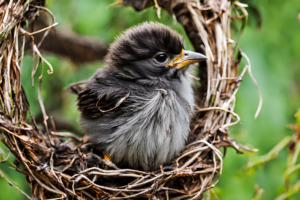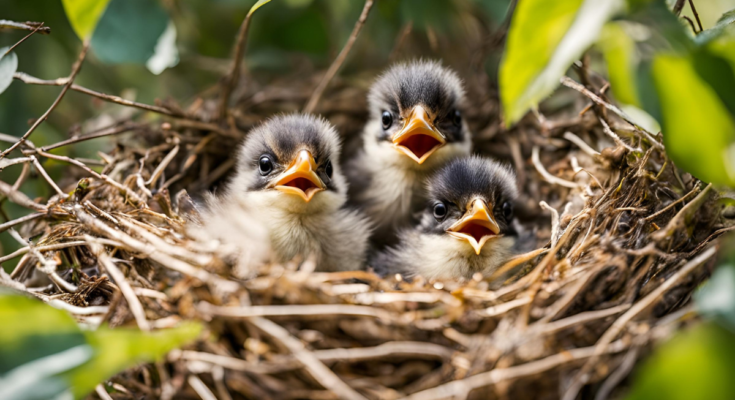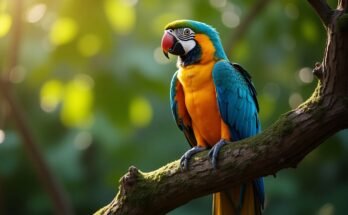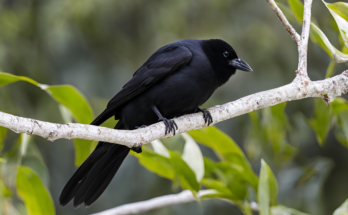Nothing can be as pleasing to the eyes in various forms of nature as a baby bird with a yellow beak which symbolizes new life. This is more of a structural peculiarity typical of some young birds in the early stages of development and is said to fulfill the need for both form and functionality. The color of the beak is yellow, the same as the color of the legs but the importance of this beak is great since it works as a signal for parents. As for the chickadees and titmice, the yellow beak assists the parents in identifying which of the babies need to be fed again.
Besides the utilitarian aspect, the yellow beak also has esthetic value as the baby bird is rendered with a pleasant, natural look symbolizing life in its entirety and purity of the being. During the nesting season, these small birds prefer to stay anchored in their round-shaped nests and their beaks are mainly yellow. Their soft down and contrastive bright yellow beaks make them some of the most cute animals known to man. It is evident from the dimensions of this micro marvel that it spearheads the life’s book, a thrilling life’s journey to growth and survival amongst these flying creatures.
Why Baby Birds Have Yellow Beaks: A Fascinating Evolution

The subject of the reasons behind the yellow coloration of the beaks of baby birds reveals an interesting aspect of birds’ development. This Blackburn testify/ These brightly colored patches of skin are thus due to natural selection for, for instance, chicks with yellow or orange beaks will have better prospects of survival.
The yellow beak had a purpose to show the parent bird that the chick wants to be fed, that is it has been starved. Indeed, studies indicate that parents preferentially feed chicks that have bright-colored mouths and hence these birds stand higher chances of survival when compared to their counterparts with dull-colored mouths.
The rationale for the evolution of the yellow beak is however easily discernable-that way, it becomes easy to feed the chick and hence improve the chances of its survival. This trait is present more often in small passerines such as chickadees like – the black-capped chickadees, and the Boreal chickadees where the competitors are the siblings.
While the black “mask” remains visible throughout the life of the bird, the yellow coloration is believed to be derived from carotenoid pigments; the bird’s yellow beak is consumed and reabsorbed through its diet. It has been developed over generations to improve the odds of survival of the species in question, and an excellent example illustrating the effectiveness of the forces as a natural phenomenon is provided.
Caring for a Baby Bird with a Yellow Beak
Rearing a baby bird with a yellow beak involves a degree of knowledge as to what is suitable for the young bird at this time. These baby birds particularly during the first weeks, cannot survive on their own and they have to rely on parents or human attendants. Proper feeding is one of the most important tasks that have to be done when taking care of these animals.
The diet by parents in the wild is usually a high-protein diet that includes invertebrates and insects to foster rapid growth among the young. Its bright yellow beak offers another layer of cue for the caregivers in as much as feeding is concerned so the bird gets the right feed at the right time.
Feeding is quite essential in the rearing of the baby bird but equally significant as this is the health of the baby bird in question. They need to be monitored for parasite infections or other kinds of inversions or abnormalities in the process of their development.
For instance, if the beak of a baby bird is yellow, this changes color to a dull color then it signifies the baby bird is malnourished or is infected with a certain disease. Of course, there are some critical cues that caregivers can learn to alter their approach and give the best to the baby bird. The best approach to the care of these baby birds involves; feeding and maintaining their health status, as well as offering adequate security that is closely related to that of the natural habitat.
The Mystery Behind the Yellow Beak of Baby Birds Explained
List of Issues that Interest Birdwatchers and Researchers • Long yellow beak of baby birds. Thus it serves more than just the purpose of ornaments, since the calls help the chicks and their parents to communicate with each other. Depending on the subspecies, gape flanges may be yellow or orange; when baby birds open their mouth, they expose these bits of color which announce to the parents that it is time to feed, useful mostly when the chicks are completely helpless. The degree of color produces more chances that the chick will be attended to by its caregivers as seen from the external situations.
But it does to when one looks at the big picture of the workings of the yellow beak. Researchers have also noted that in certain species — for example, in the American dipper and several tyrant flycatchers — the elated yellow hue of juveniles dulls upon the bird’s sexual maturity.
This raises the possibility that only the yellow beak is a secondary structure, which is especially adapted for use in the selectively vulnerable chick stage. This is because the beak color may change as the bird becomes independent thus implying a change in calls for feeding as well as signaling. This understanding of this system, therefore, leads to a better understanding of avian behavior and their ability to adapt to its natural conditions.
Baby Birds and Their Bright Yellow Beaks: What It Means
First, the bright yellow beak serves more purposes than merely utilitarian in the young birds; To the parent birds, it means that the chick requires food hence the feature serves as a call for food to be provided. However, beyond the functional aspect, the yellow beak also points to the fact that the bird is young and still dependent. In some of the species, the yellow beak acts like an arrow with a pointer pointing to the weaker members of the family that require protection from animals or even harsh conditions in the environment.
The bright yellow beak can also be an alert to the general health of the particular bird, in question. In general, it can be seen that chicks with a more saturated beak color are relatively healthier in comparison to the chicks that are pale and look sick or at least malnourished.
Thus, the link between beak color and health proves that the yellow beak is a useful instrument not only for a bird’s parents but for any other person, who sees young birds in the wild or captivity. This small but powerful feature summarises the condition of the bird and how it remains helpless and dependent on the kind of care it gets in the early days of its life.
Yellow-Beaked Baby Birds: The Beauty of Avian Beginnings
It is the beauty of seeing a baby bird with its yellow beak because it is an important period and aspect of the development of the bird. When they are born, several birds especially the newborn ones have this bright yellow bill which makes them conspicuous in their habitats.
The yellow beak impressing against the down-like garments that cover their body; makes them one of the most adorable species in the natural world. The natural yellow color helps their parents locate them where they are, so these young ones can be fed and cared for until they develop into healthy fledglings.
The innocence of the bird with a yellow beak that is growing into a young mom is still a reminder of the existence of the natural cycle. With the passage of days, the baby bird will be able to grow real feathers and cast off the soft feathers that they are born with.
Its beak may turn black or just disappear as it grows up but the yellow beak is very essential during the first part of its life cycle. It is expressed through the changing physical appearance of a bird from the moment when the beak is visible in the initial stage of development up to the moment when the bird is most developed.
Understanding the Yellow Beak: Insights into Baby Bird Development
The colors of a baby bird’s beak are depicted and in this case, the color yellow is seen on the beak. During the developmental period of their lives, the purpose of the yellow coloration is to convey hunger and the need for social interaction.
This bright color is especially striking in species such as chickadees and titmice, in which the Paridae family uses this color to understand which of its chicks is hungry. The yellow beak also has an important function of provoking the parents to continue to feed their young until they have strengthened enough to leave the nest.
This is usually the case because as the baby bird grows older, the beak may lose some of its color or turn a different color altogether, starting a new phase. Such a change in color means that the bird is gradually growing up, which means that it runs for food and not depending on its parents.
That is why the changes in the beak, increase of the plumage features, and appearance of the ability to find food itself, are the evident signs that the bird is ready for the next stage in its life. An understanding of these changes in beak coloration aids bird lovers and scientists especially when trying to monitor the progress of young birds from the hatchlings to the fledglings.
Nature’s Charm: The Unique Yellow Beak of Baby Birds
It is not so easy to describe but I suppose there’s a certain kind of cute appeal to a baby bird’s yellow beak. It is spotted right at first glance and helps to separate these young beasts and also as a survival mechanism. To clarify, the yellow beak is a physical characteristic, as well as proof of life’s instability by symbolizing the stages of development as beginners in such species as the American dipper and tyrant flycatchers.
When baptizing these baby birds in their nests, the sizes of the bodies of some of these birds could hardly compare to the intensity of the yellow in the beaks of the birds which serve as indicators of the vulnerability of nature.
This beige-colored beak that is seen in the bird also serves the cultural and symbolism for those who enjoy the views of avian lives. Most bird watchers and nature enthusiasts regard the yellow beak as a symbol of the ‘new beginnings ‘of the cycle of life and nature.
Whether still in spherical nests, starting to fledge in the open world or are partially developed fledglings, baby birds with yellow beaks are an incomparable combination of cuteness and nature, which gives the public a chance to see some of the most popular and recognizable birds in their juvenile stage.
From Hatchling to Fledgling: The Role of the Yellow Beak in Baby Birds
As with all the early developmental stages in the lifecycle of birds, the period of hatching and turning into a fledging is a very important one, more so the fact that a yellow beak has a great influence on the baby birds. As soon as a baby bird hatches from its egg, the yellow beak plays an important function in the exchange of information between the young and the older birds.
The intensity of the pecking color, yellow indicates that the chick is hungry and thus the parents should feed it often. This way the baby bird is always able to feed and build the strength that it will need to fly away from the nest and be on its own.
Thus, the presence of the yellow beak as a symbol transforms from dependence on parents at an early age of the bird to a symbol of growth at a certain age of the bird. At this stage, the beak of a bird can change its color and this is a sign that the bird will have to find its food on its own.
Such change is very significant in the life cycle of the birds as a means of demonstrating the transition of birds from a state of dependence to one of self-sufficiency. Learning about how the yellow beak works in this manner gives an understanding of how the development process of birds takes place from the hatching stage right up to the stage of the young bird which is fully capable of flying.
Spotting a Baby Bird with a Yellow Beak: What You Should Know
It is always interesting to come across a baby bird with a bright yellow beak while trekking through the forests; however, it comes with its fair share of duties of bird lovers and watchmen. This is particularly true due to the yellow beak which gives a hint of the fact that the bird is still young and would be wholly relying on its parents for survival.
In the case of identifying a baby bird with a yellow beak, it is advisable next to the young bird or nest not to approach it. People’s meddling with the feeding process can upset the avian habits, for instance, its parent birds may abandon their offspring if they feel threatened.
Furthermore, at times if a bird is found lying helplessly on the ground with a yellow beak, then it is wise to get it checked immediately. Not all baby birds have to be “rescued” — in many cases, the fledglings are still learning how to fly and still receive food from their parents. However, if the bird is sick or this is a life-threatening situation, calling a wildlife rehabilitator should be the next option. It kind of makes bird watchers think and decide on what is the best course of action for the young bird’s benefit, knowing the importance of the yellow beak.
Conclusion
You thought that the yellow beak of baby birds is just a colorful addition to their overall appearance, but it plays a very important role in their growth and existence. Apart from indicating that the bird is hungry or in need of its parent’s attention, the yellow beak also has the responsibility of assisting its parents in identifying it during the early period of its development.
The most striking manifestation of this feature is the variation in the size of different body parts found in small passerines such as chickadees but it can be observed in all groups of birds. Depending on the choice made by the observer to watch it in the open air or in a cage a glimpse at a bird that has a yellow beak makes people think about how great the world of nature is and how complex are the causes that keep on supporting life on the planet.
FAQ
Q: What is the use of having some colorful patterns in the beak of a baby bird?
A: The pied kingfisher has a yellow beak which alarming color that favors parent birds to bring food to feed its chick considering that the early developmental years are crucial for chicks.
Q: Is it true that all newly hatched birds have yellow beaks?
A: Not all the babies have a yellow beak but it is perhaps the most prominent color known among the small passerines including chickadees and titmice.
Q: Does it change with the age of the bird? If yes what color is the yellow beak of the mature bird?
A: Yes, depending on the kind of bird, the yellow coloration could easily wash off as the bird grows older, the beak too may change color especially when the little bird is fed by its parents and is now on specialized food as seen in the fledgling stage.




One Comment on “Adorable Baby Bird with Yellow Beak”